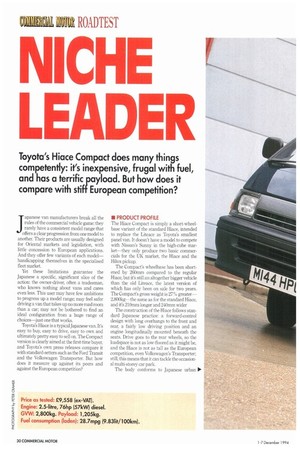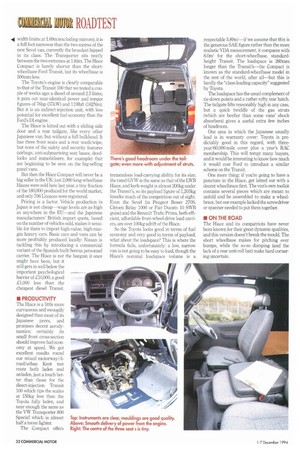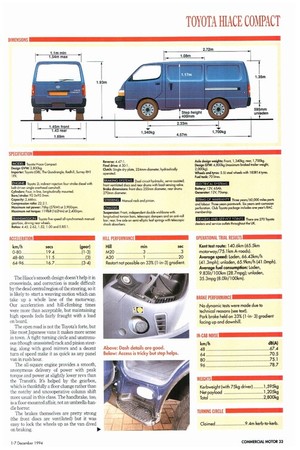NICHE LEADER
Page 32

Page 34

Page 35

Page 36

If you've noticed an error in this article please click here to report it so we can fix it.
Toyota's Hiace Compact does many things competently: it's inexpensive, frugal with fuel, and has a terrific payload. But how does it compare with stiff European competition?
Japanese van manufacturers break all the rules of the commercial vehicle game: they rarely have a consistent model range that offers a clear progression from one model to another. Their products are usually designed for Oriental markets and legislation, with little concession to European applications. And they offer few variants of each model— handicapping themselves in the specialised fleet market.
Yet these limitations guarantee the Japanese a specific, significant slice of the action: the owner-driver, often a tradesman, who knows nothing about vans and cares even less. This user may have few ambitions to progress up a model range; may feel safer driving a van that takes up no more road room than a car; may not be bothered to find an ideal configuration from a huge range of choices—just one that works.
Toyota's Hiace is a typical Japanese van. It's easy to buy, easy to drive, easy to own and ultimately pretty easy to sell on. The Compact version is clearly aimed at the first-time buyer, and Toyota's own press releases compare it with standard-setters such as the Ford Transit and the Volkswagen Transporter. But how does it measure up against its peers and against the European competition?
• PRODUCT PROFILE
The Hiace Compact is simply a short-wheelbase variant of the standard Hiace, intended to replace the Liteace as Toyota's smallest panel van. It doesn't have a model to compete with Nissan's Sunny in the high-cube market—they only produce two basic commercials for the UK market, the Hiace and the Hilux pickup.
The Compact's wheelbase has been short. ened by 260mm compared to the regular Hiace, but it's still an altogether bigger vehicle than the old Liteace, the latest version of which has only been on sale for two years. The Compact's gross weight is 27% greater2,800kg—the same as for the standard Hiace, and it's 210mm longer and 240mm wider The construction of the Hiace follows standard Japanese practice: a forward-control design with long overhangs to the front and rear, a fairly low driving position and an engine longitudinally mounted beneath the seats. Drive goes to the rear wheels, so the loadspace is not as low-floored as it might be, and the Hiace is not as tall as the European competition, even Volkswagen's Transporter; still, this means that it can tackle the occasional multi-storey car park.
The body conforms to Japanese urban 110
width limits: at 1.69m (excluding mirrors), it is a full foot narrower than the two metres of the new Sevel van, currently the broadest-hipped in its class. The Transporter sits neatly between the two extremes at 1.84m. The Hiace Compact is barely shorter than the shortwheelbase Ford Transit, but its wheelbase is 500mm less.
The Toyota's engine is clearly comparable to that of the Transit 100 that we tested a couple of weeks ago: a diesel of around 2.5 litres, it puts out near-identical power and torque figures of 76hp (57kW) and 119lbft (162Nm). But it is an indirect-injection unit, with less potential for excellent fuel economy than the Ford's DI engine.
The Hiace is kitted out with a sliding side door and a rear tailgate, like every other Japanese van, but without a full bulkhead. It has three front seats and a rear wash/wipe, but none of the safety and security features (airbags, anti-submarining seat bases, deadlocks and immobilisers, for example) that are beginning to be seen on the big-selling panel vans.
But then the Hiace Compact will never be a big seller in the UK: just 2000, long-wheelbase Hiaces were sold here last year, a tiny fraction of the 180,000 produced for the world market, and only 706 Liteaces were registered.
Pricing is a factor. Vehicle production in Japan is not cheap—wage levels are as high as anywhere in the EU—and the Japanese manufacturers' British import quota, based on the number of vehicles sold, makes it sensible for them to import high-value, high-margin luxury cars. Basic cars and vans can be more profitably produced locally: Nissan is tackling this by introducing a commercial variant of the Spanish-built Serena personnel carrier. The Hiace is not the bargain it once might have been, but it still gets in well below the important psychological barrier of £10,000, a good £1,000 less than the cheapest diesel Transit.
• PRODUCTIVITY The Hiace is a little more curvaceous and swoopily designed than most of its Japanese peers, and promises decent aerodynamics; certainly its small front cross-section should improve fuel economy at speed. We got excellent results round our mixed motorway/Aroad/urban Kent test route both laden and unladen, just a touch better than those for the direct-injection Transit 100 which tips the scales at 150kg less than the Toyota fully laden, and near enough the same as the VW Transporter 800 Special which is almost half a tonne lighter.
The Compact offers tremendous load-carrying ability for its size; the rated GVW is the same as that of the LVVB Hiace, and kerb weight is almost 200kg under the Transit's, so its payload figure of 1,205kg knocks much of the competition out of sight. Even the Sevel (in Peugeot Boxer 270S, Citroen Relay 1000 or Fiat Ducato 10 SWB guise) and the Renault Trafic Prima, both efficient, affordable front-wheel-drive load carriers, are over 100kg adrift of the Hiace.
So the Toyota looks good in terms of fuel economy and very good in terms of payload; what about the loadspace? This is where the formula fails, unfortunately: a low, narrow van is not going to be easy to load, though the Hiace's nominal loadspace volume is a
respectable 5.89m3—if we assume that this is the generous SAE figure rather than the more realistic VDA measurement, it compares with 6.0in for the short-wheelbase, standardheight Transit. The loadspace is 260mm longer than the Transit's—the Compact is known as the standard-wheelbase model in the rest of the world, after all—but this is hardly the "class-leading capacity" suggested by Toyota.
The loadspace has the usual complement of tie-down points and a rather nifty rear hatch. The tailgate lifts reasonably high in any case, but a quick twiddle of the gas struts (which are beefier than some vans' shock absorbers) gives a useful extra few inches of headroom.
One area in which the Japanese usually lead is in warranty cover: Toyota is predictably good in this regard, with threeyear/60,000-mile cover plus a year's RAC membership. This will tempt many buyers, and it would be interesting to know how much it would cost Ford to introduce a similar scheme on the Transit.
One more thing if you're going to have a puncture in the Hiace, get kitted out with a decent wheelbrace first. The van's own toolkit contains several pieces which are meant to unfold and be assembled to make a wheelbrace, but our example lacked the screwdriver or spanner needed to put them together.
• ON THE ROAD The Hiace and its compatriots have never been known for their great dynamic qualities, and this version doesn't break the mould. The short wheelbase makes for pitching over bumps, while the so-so damping (and the lack of a rear anti-roll bar) make hard cornering uncertain.
The Hiace's smooth design doesn't help it in crosswinds, and correction is made difficult by the dead central region of the steering, so it is likely to start a weaving motion which can take up a whole lane of the motorway. Our acceleration and hill-climbing times were more than acceptable, but maintaining high speeds feels fairly fraught with a load on board.
The open road is not the Toyota's forte, but like most Japanese vans it makes more sense in town. A tight turning circle and unstrenuous (though unassisted) rack and pinion steering, along with good mirrors and a decent turn of speed make it as quick as any panel van in rush hour.
The all-square engine provides a smooth, anonymous delivery of power with peak torque and power at slightly lower revs than the Transit's. It's helped by the gearbox, which is thankfully a floor change rather than the notchy and uncooperative column shift more usual in this class. The handbrake, too, is a floor-mounted affair, not an umbrella-handle horror.
The brakes themselves are pretty strong (the front discs are ventilated) but it was easy to lock the wheels up as the van dived
on braking. 111. • CAB COMFORT The interior is a cut above the average Japanese light commercial set-up-it looks like an 80s van rather than a late 70s job. The instruments are clear (though the speedometer was 11% optimistic at 30mph) and the interior mouldings are of good quality.
All the small details on the Hiace look a touch better made than those of its compatriots. But there are no airbags or (most impor tantly) cup holders the latest Transit sets the standard here-and the radio is not listed in the standard equipment.
Noise levels are higher than the Ford's; at speed it is mainly wind noise that intrudes, while by contrast engine and road noise are very well controlled.
The most immediately infuriating feature of Oriental vans, still in evidence here, is the retention of a right-hand indicator stalksemaphore from the windscreen wipers just isn't the same, somehow The seats are reasonably comfortable, if you don't mind the slightly cramped feeling and the tricky cab access which is to be expected of a forward-control van. That centre seat is a joke: it's tiny, but even if you could coax Dopey, Grumpy or one of their friends to sit they he would bang their little legs on the gear lever. • SUMMARY The Hiace Compact will be all things to some men. It's inexpensive, it's frugal with fuel, there are few distracting options (although it is promised that "a full range of Toyotaapproved accessories will be available"), and round town it's perfectly competent.
The more discriminating buyer will be attracted to the Compact's terrific payload and apparent build quality, but may be put off by the shape of the loadspace, the doubtful dash resistance of the forward-control layout and the van's poor motorway manners.
The Compact certainly looks like good value against its long-wheelbase siblings. It's £1,748 cheaper than the 2.5-litre petrol model (though that boasts 118hp) and a whopping £2,193 less than the diesel; that's a lot to pay for a little more volume and a little less payload.
Alternatively there's Renault's Trafic, which in Prima T900 diesel form costs about £900 less than the Compact: it's slower and a little rougher round the edges, and can't match the Toyota's three-year warranty, but load volume and accessibility are better. Decisions, decisions...
If you can stretch to a little more cash the charms of the Transit, Transporter and Sevel vans cannot be ignored, particularly for lengthy journeys. None offers the payload of the Hiace, but neither do they feel quite
as stretched when fully laden. And their range of security and safety features are impressive.
There's much to like about the Toyotacertainly the most attractive of Japanese panel vans-but it is really only the leader in a niche market.
17 by Toby Clark
























































































